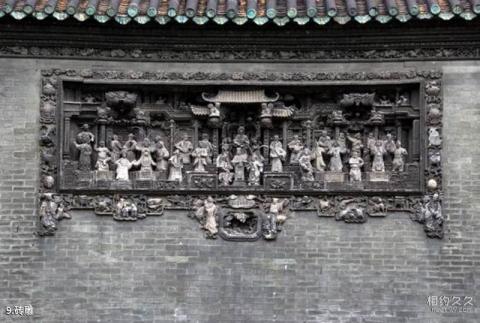
Introduction to brick carving: Brick carving, a folk craft form that has been popular in the Ming and Qing Dynasties, is widely used in ancestral halls, guild halls, temples, and residential walls, heads, screen walls, under eaves, door lintels, window foreheads, etc. at. Guangdong brick carvings use refined water-polished blue bricks as materials, and the carving techniques are mostly interspersed with intaglio, bas-relief, high-relief, and openwork carvings. The flowers and leaves carved are lush and brocade-like, and the opera characters have clear clothes and armor. They are carved in the sunlight at different times. Under the irradiation, it shows different colors such as black, white, green gray, etc. The picture has clear layers and rich fluctuations, and the fine ones can reach seven or eight layers.
In the buildings of Chen's Academy, brick carvings are used to decorate the exterior walls, crests, eaves, etc. These exquisite brick carvings are from Huang Nanshan, Yang Jianting, Li Bizhu, Chen Zhaonan, Liang Cheng, Liang Jin, etc. in Nanhai and Panyu. The hands of famous folk artists mainly use relief carvings, and partially adopt techniques such as openwork carvings, round carvings, and hollow carvings. They arrange patterns and decorations as needed, enriching the monotonous walls and highlighting the style of Guangdong brick carvings. It added a lot of color to the building and became a representative of Lingnan architectural brick carving art in the Qing Dynasty.
There are 6 large-scale brick carvings on the front facade of Chen's Academy. Among them, the two brick carvings "Liangshan Juyi" and "Liu Qingfu Langju" are both 1.75 meters high and 3.6 meters wide. The remaining four brick carvings are respectively They are "Picture of Hundreds of Birds", "Picture of Five Luns", "Picture of Wutong, Apricot, Willow and Phoenix", and "Picture of Pine Bird". There are also poems in different calligraphy styles carved on both sides of the picture. Its scale and the form of combining poetry, calligraphy and painting are all the same. It is rare in the same period; the decorative lines under the eaves of the outer wall and on the corridor door are neatly arranged, dense and vigorous, slender and even, vertical like lines, and the carving is exquisite, known as "hanging line brick carving"; the main building of the academy has three entrances and three roads. The ridges outside the nine halls are also decorated with brick carvings. The tops of these brick carvings are carved bucket arches, thematic decorative patterns are in the middle, the upper and lower sides are border patterns, and the lower part is the subtitle pattern and signature. Its themes include auspicious patterns, folklore, historical stories, etc. Such as: "Magpies climbing plum blossoms", "rats gnawing grapes", "gold and jade in the hall", "dragon and phoenix present auspiciousness", "grand master and young master", "bamboo crane picture", "spring swallows in the apricot forest", "melons and melons", " "Dongfang Shuo steals peaches", "Ma Gu offers birthday", "Hehe two immortals", "Tianji sends her son off", "Gathering of heroes", "Cao Cao's banquet on the Bronze Bird Terrace", "The Jade Emperor ascends the palace", "Ganlu Temple", " "Talking with Confucians" and so on.
